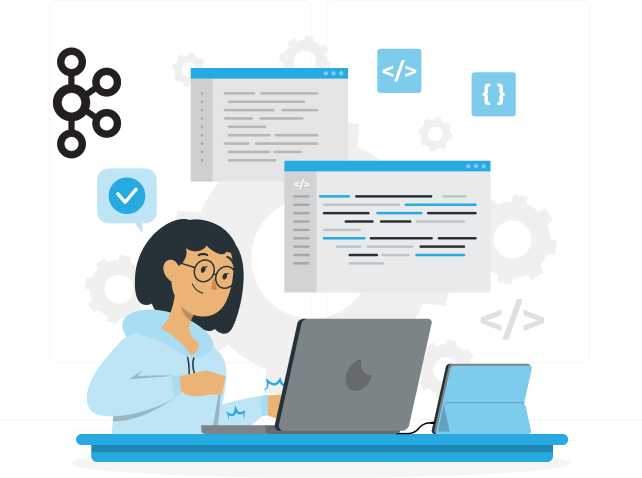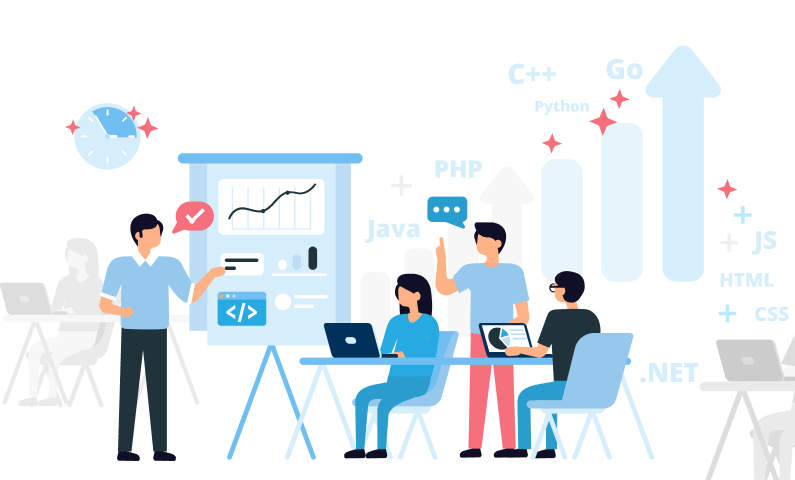There is no doubt that education has really evolved, especially with technology leading the way. Since the COVID-19 pandemic hit, online education has skyrocketed.
And this is why you have come to this blog, right? We understand that getting students to put down their phones and stay focused in class is no easy task. Here’s our suggestion: you can turn that distraction into an opportunity to upgrade your teaching methods.
Now, allow us to introduce you to the benefits of computer assisted learning you can make the most of.
What is Computer Assisted Learning?
Computer-assisted Learning refers to a wide array of technologies and tools used to support and enhance education. At its core, it involves using electronic devices, like computers, to deliver educational content and assist in learning. Several specialized institutions in computer and information technology describe CAL as “the use of electronic devices/computers to provide educational instruction and facilitate learning.”
However, CAL is not limited to computers; it also includes devices like CD and MP3 players, DVD players, tablets, smartphones, and even television. These tools help teachers explain concepts more effectively and engage students in the learning process.
Currently trending, CAL also covers online courses and additional course materials used in various educational settings, such as colleges, homeschooling, and distance learning. So, in a nutshell, any technology that aids in education can be considered a part of CAL, highlighting its broad and inclusive nature.
This brings us to EdTech and mobile learning platforms.
Plus, with mobile devices becoming such a big part of education, learning isn’t limited to the classroom anymore. Students can learn whenever and wherever they are, which really encourages their learning journey.

Exploring the Benefits of Computer-assisted Learning
The magic mantra is you have to keep up with the times. CAL can effectively complement traditional language education and enhance overall learning experiences. Let’s quickly examine the benefits and how you can amp up your learning system.
Flexibility and Accessibility
One of the benefits of computer assisted learning is it lets you learn on your own terms. Now, that’s like breaking away from the usual classroom routine. You can go about using your educational resources whenever you want, whether it’s on your laptop or your phone. Of course, we can’t skip mentioning the platforms like Coursera and edX, which allow you to study at your own pace.
Personalized Learning
Among the benefits of computer assisted learning, CAL systems thrive on intelligent algorithms and adaptive technologies to tailor content and instruction to each learner’s needs and progress. For instance, platforms like Khan Academy dynamically adjust lessons, offering extra practice in challenging areas and swiftly advancing students through mastered concepts. This personalized approach ensures that every student receives targeted support, enhancing their comprehension and retention of educational materials.
Interactive and Engaging Environments
Integrating multimedia elements, simulations, and gamified features into CAL fosters interactive and engaging learning environments. For example, educational software like Scratch introduces students to programming concepts through interactive simulations and game-like challenges, transforming learning coding into an enjoyable and academic experience. Such interactive tools promote hands-on experimentation and peer collaboration, enhancing learning outcomes and student satisfaction.
Development of Digital Literacy
Among the benefits of computer assisted learning, CAL is pivotal in developing digital literacy skills essential for success in today’s digital age. Students these days are learning a lot more than just textbooks. They’re enjoying online courses, exploring different software, and engaging with digital content. For instance, take platforms like Google Classroom and Microsoft Teams. They work as virtual classrooms where students learn to chat, share files, and join discussions online. When students are honing their skills like this, these aren’t just handy for school; they are up for success in their education and future careers.
So, by tapping into the benefits of computer assisted learning and using real-life examples, educators can create learning experiences that really click with students’ different interests and ways of learning. The result? It develops a more effective and engaging educational experience for students.
Why Are the Benefits of Computer Assisted Learning Undeniable?
The global edtech and smart classroom market was valued at USD 115.80 billion in 2022. But hold on, there’s more to it. The market will grow even further, reaching around USD 433.17 billion by 2030. That’s a solid growth rate of 18.3% annually.
The education sector is really buzzing with opportunities as schools and learners everywhere realize the benefits of a well-rounded learning environment and are investing more in it.
According to education experts at HolonIQ, about 3% of global education spending is already dedicated to digital infrastructure. They also foresee that the digital transformation could skyrocket to USD 10 trillion by 2030, but keep in mind that it was USD 6 trillion in 2018. This trend is sure to drive smart classroom solutions in the years ahead.

The Rise in User Engagement Demand
As the need for engaging users grows, so do the opportunities in the Edtech market. Edtech solutions are amped up to be user-friendly and simple to access. This is a surefire way to make learning accessible for all kinds of learners.
Some students learn visually, others prefer auditory methods; some like bite-sized learning, and others enjoy extensive reading sessions. Consequently, personalization is a crucial Edtech trend, leveraging AI and Big Data to tailor educational experiences.
Machine Learning, in particular, can analyze user behavior, interests, and personality traits, identify areas for improvement, and provide personalized lessons at the student’s pace. One of the benefits of computer assisted learning is increased retention, which happens by incorporating competitive or game-like elements.
For instance, Duolingo enhances engagement through various features:
- Experience Points (XP) as completion awards.
- Local and global leaderboards.
- Leagues based on XP earned.
- Streaks and random challenges for extra XP.
- Crowns for mastering levels.
- Hearts, functioning like extra lives in video games.
- Internal currency for purchasing items in the in-app shop.
K-12 Education in EdTech and Smart Classrooms
Technology has become integral to children’s lives. Kindergarten classrooms are integrating technology to benefit both students and teachers, which is making students active participants in their learning.
The K-12 education system, covering primary and secondary education for students aged four to 18, varies by country but has universally embraced technology to create tech-savvy learners. EdTech solutions provide significant advantages for schools, offering fast and interactive teaching through animations, videos, and audio features.
Among the benefits of computer assisted learning, EdTech solutions are widely implemented in classrooms, home learning, and assignments in countries like the US, Canada, France, and Singapore. Emerging economies such as China, India, and Brazil are also exploring EdTech, with government support for mobile learning and low-cost devices.
Interactive Projectors in EdTech and Corporate Spaces
Interactive projectors are set to grow at the second-highest CAGR among hardware segments in the coming years. These devices take a computer’s display and project a larger version onto a flat surface, making them useful for presentations in classrooms, home theaters, and corporate settings.
What makes interactive projectors stand out is their capability to let users interact directly with the projected image. Whether it’s touching the screen, using the projector itself, or through another device, they transform any surface into an interactive whiteboard. This allows presenters to engage with the content using a stylus or simply their finger.
Some interactive projectors come with advanced features like capturing, replaying, printing, or copying user-generated content, with or without the original image. These capabilities are particularly beneficial in educational settings, where multi-touch functions facilitate group projects and interactive games, enhancing cognitive learning for students. In corporate environments, interactive projectors allow presenters to annotate directly on the screen, making presentations more dynamic and engaging.
The ability to digitally share notes and engage in collaborative activities has also increased the popularity of interactive projectors. Just like smartphones and tablets, they support multi-touch functionality, allowing multiple users to work together on tasks such as completing puzzles, which then promotes teamwork and interactive learning.
14 Computer-Assisted Learning Approaches to Enhance Learning
The benefits of computer assisted learning include a range of intuitive approaches that revolutionize education with their distinct attributes. These approaches cater to diverse learning styles and preferences, making learning more engaging and effective. Here’s a closer look at the key characteristics of CAL:
1. Interactive Tutorials
Tutorials in CAL act as comprehensive guides, offering step-by-step instructions and detailed content to deepen understanding of specific subjects. They provide a structured learning path, helping students clearly navigate complex concepts.
2. Dynamic Simulations
CAL incorporates simulations—virtual environments that replicate real-world scenarios. These simulations enable hands-on experimentation, allowing learners to apply theoretical knowledge practically. They bridge the gap between theory and application, fostering a deeper grasp of complex ideas.
3. Skill Reinforcement Programs
Certain CAL programs focus on repetitive skill reinforcement, using practice-oriented approaches to enhance specific abilities. Through consistent exercises, these programs ensure mastery of particular skills, reinforcing knowledge through deliberate practice.
4. Gamified Learning
Have you ever considered learning as a game? Gamified learning is becoming a reality. Now, that’s one of the best benefits of computer assisted learning, which makes education fun by adding challenges, rewards, and a bit of competition to the mix. It turns learning into something exciting and keeps students motivated and eager to learn more.

5. Multimedia Learning
One of the cool benefits of computer assisted learning is multimedia learning. It uses different media like videos, interactive tools, and audio to give you a richer learning experience. This way, everyone gets to learn in a way that suits them best, making education more immersive and engaging than just reading from a textbook.
6. Intelligent Tutoring Systems (ITS)
Intelligent Tutoring Systems are like having a smart tutor right there with you. Using artificial intelligence, these systems study how you learn and what you need help with, then tailor lessons to fit you perfectly. ITS makes learning easier and more effective by giving you exactly the support and guidance you need.
7. Virtual Labs
Virtual labs in CAL act like real labs but in a digital space, letting you do experiments and explore scientific stuff online. They’re safe and easy to use, giving you hands-on learning experiences that really boost your understanding in different subjects.
8. Collaborative Learning Platforms
CAL integrates collaborative learning platforms that foster group interaction among students. These platforms promote shared learning experiences, encouraging project collaboration, idea discussions, and problem-solving. They create a sense of community and engagement within virtual educational spaces.
9. Mobile Learning (mLearning)
Among the benefits of computer assisted learning, mobile Learning is a dynamic aspect of CAL. It utilizes mobile devices to deliver educational content anytime, anywhere. This flexible approach breaks traditional learning barriers, enhancing accessibility and accommodating modern students’ diverse lifestyles.
10. Interactive Whiteboards
Interactive Whiteboards within CAL offer educators a digital canvas to create interactive presentations. These tools enable teachers to incorporate multimedia elements, annotate content, and engage students in real-time participation. Interactive Whiteboards enrich the teaching and learning experience with dynamic educational interactions.
11. Learning Management Systems
Learning Management Systems are the nucleus of CAL. They are here to stay and make organizing, delivering, and tracking educational content silky smooth. These platforms are in high demand in the edtech space as they simplify managing learning resources, help educators set up courses, and check on student progress. The best part of an LMS is that it makes everything run smoothly, whether you’re teaching in a classroom or online.
Check out our learning management system.
12. Adaptive Learning Systems
Imagine learning that’s all about you. This is one of the benefits of computer assisted learning. Adaptive Learning Systems fit the bill in personalizing education by adjusting what you learn and how fast it is based on your progress. They use data to figure out your strengths, weaknesses, and what you like best so you get just the right help and challenges to help you learn better.
13. Augmented Reality and Virtual Reality
Think about learning where you’re not just reading or watching but actually stepping into a new world. Now, we aren’t far from studying Augmented Reality and Virtual Reality in CAL. These technologies are changing how we learn by putting us right in the middle of things. For instance, AR and VR create 3D environments where you can interact in ways that go way beyond textbooks. AR and VR make learning more exciting and easier to understand by bringing sensory-rich experiences right to you.
14. Computer-Mediated Communication
Computer-mediated communication is one of the benefits of computer-assisted learning. It makes it easy for learners to interact and collaborate through digital channels. CMC lets students chat, share ideas, and work on projects together, especially in virtual learning environments. This is sure to make learning more social and create a supportive community.
Each feature in CAL improves educational experiences. It’s a proper implementation of technology to cater to the diverse needs of modern learners, enriching the educational landscape with interactive and personalized learning opportunities.
Conclusion
Computer-assisted learning is a transformative force in education you can’t look away from. It digitizes traditional teaching methods and expands the scope of learning opportunities. Throughout our exploration of its definition, diverse types, and associated advantages and disadvantages, CAL emerges as a multifaceted tool with profound implications.
CAL’s adaptability is evident across educational levels, from primary schools to higher education, addressing the unique needs and developmental stages of learners. Successful implementations like Khan Academy, Duolingo, and interactive platforms such as SMART Boards highlight CAL’s effectiveness in enhancing accessibility, engagement, and personalized learning experiences tailored to individual learning styles.
As technology keeps advancing, so will CAL. It should give educators and learners new and exciting ways to collaborate, explore, and succeed in the digital age. However, one must recognize the benefits of computer-assisted learning, where education is about more than just sharing knowledge.
We can help you maximize its potential. Schedule a consultation call and discover our EdTech services.

Start a Project with Ajackus











































































